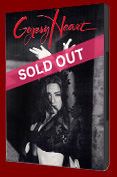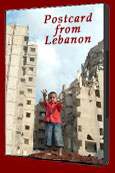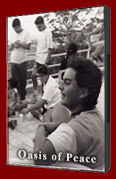FLAMENCO / CARMEN AMAYA
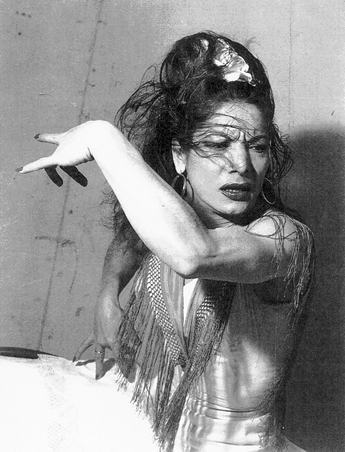 ON FLAMENCO
ON FLAMENCO
Flamenco is a Classic Art and a Folk Art, which emerged officially in the 19th century as the musical tradition of Andalucia, in the South of Spain, a tradition forged by Gitanos (Gypsies, today correctly called Romanies) and non-Gypsies representing a diversity of cultures. But for the Romanies who settled in the Iberian Peninsula, in the 15th century, and who were persecuted over 300 years, Flamenco is a native musical language which is lived day by day. It is their “Blues”. Carmen Amaya is one of their greatest exponents.
The three basic elements of Flamenco are : song (cante), dance (baile) and guitar (guitarra).
No one really knows the origin of the word Flamenco (the best theory is that it comes from the defiant Flemish soldiers who had a certain posture and attitude. In fact, Flamenco literally means Flemish. Flamenco is both Spanish and Gypsy, but despite the denial of many Spaniards, the Spanish Romanies are at its core. Even when Non-Gypsies were revising Flamenco forms, they took the image of the Gypsy as a central theme or claimed to be Gypsies themselves.
But, Flamenco is also the merging of two melting pots with the Gypsies at the helm. Before the Gypsies landed in Spain in the 15th century, Andalucia had a rich culture of Phoenicians, Greeks, Romans, Visigoths and 700 years of Moorish rule. In fact, the deep wailing of the cante jondo is probably a combination of Indian and Arab, Hebrew and Gregorian chanting. The word ole, comes from Allah. So Andalusian folk music and dance created the environment to which the Gypsies brought their own melting pot (since the Gypsies came originally from India, through Egypt, Turkey etc).
The Andalusian folk music was festive and public accompanied often by simple orchestras and percussion instruments (castanets). The Gypsies, however, persecuted and abused for over 300 years, under constant threat of imprisonment and death, developed a “blues” tradition which was private, personal and ritualistic. Often they were too poor to have instruments so they used their hands “clapping” (palmas), and footwork (zapateado). In fact, the rhythms of Flamenco are prescribed by specific emotions, experiences and stories: Alegrias (happiness), soleas (solitude), bulerias (making fun), siguiriyas (wailing laments). Within these patterns of complex rhythmic phrasing (compas), the artists can improvise as much as they want.
Finally, in the 1860s the two cultures meet in the café cantantes (the cafes where artists perform). The amalgamation of these two forms led to “official” Flamenco, with the Gypsies and the Gypsy image doing most of the work. The Gypsies became the great artists of the day, inventing transforming, revising and preserving forms, from both cultures into a unique and pure art.
Flamenco is a rare combination of grit and geometry, deep spirituality and eroticism, the angle and the curve. Where ballet is a denial of gravity and a denial of the body, Flamenco is an affirmation of gravity and an affirmation of the body, in all its aspects. And then there is the concept of DUENDE, a term coined by the great Spanish poet, Federico Garcia Lorca, who among other things, was a Flamenco intellectual and an aficionado. Duende means: soul, fire: to be possessed by such fire, passion and art that the dance becomes one with the artist, in complicity with the audience. The artist experiences his own potential at such a high level that he/she goes into mystical frenzy, a kind of trance, to which we respond in kind. You can see a clue of this in the clips of Carmen’s dancing in Queen of the Gypsies.
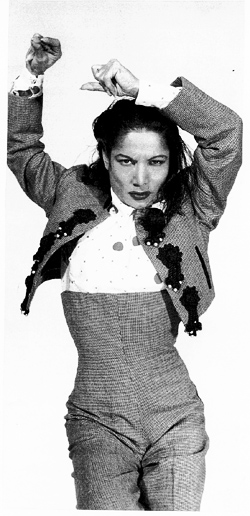 CARMEN AMAYA
CARMEN AMAYA
Born, in abject poverty, Carmen Amaya started to dance at the age of four on the streets of her native Barcelona, accompanied by her father playing the guitar. By the time she was 23 she had become a star of Spanish cinema and soon after, the darling of Hollywood and Broadway.
The fire, grit, electricity, passion and “duende” (soul) of the Gypsy style which we associate with Flamenco is largely due to the contribution of Carmen Amaya. But, Amaya was also a pioneer. Before her, women did very little footwork. She changed the role of women from one of passive posture to masculine ferocity and virtuosity. She wore pants like a man and surpassed the men in the speed, complexity and attack of her footwork. Yet Amaya also embodied sensuality and expressiveness.
Even today she remains unequaled. She was a genius whose talent was matched, according to all accounts, by her generosity and goodness. Nobody before or after has managed to transmit such strong, almost electrical energy, such “duende”.
She will be forever identified with the passion of Spanish dance.
QUEEN OF THE GYPSIES, a Portrait of Carmen Amaya (1913-1963) This biography is the first American film portrait of revolutionary Spanish dancer, Carmen Amaya.
QUEEN OF THE GYPSIES is the most comprehensive video history, to date, on the life and art of Carmen Amaya, a collector’s item. Interviews with family members, scholars, friends and former company members give Amaya’s spectacular virtuosity a personal dimension. Click here to read reviews.
-With original music by Carmen Amaya, Sabicas and Domingo Alvarado.
-81 minutes, video, NTSC format only, black and white and color.
-Spanish, French and English with subtitles.
QUEEN OF THE GYPSIES is now available on DVD (NTSC format)
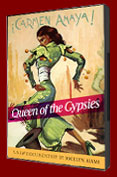
Other Videos from Gypsy Heart Productions
BEST LINKS FOR FLAMENCO TODAY
Omayra Amaya, Flamenco Dance Company
www.OmayraAmaya.com
